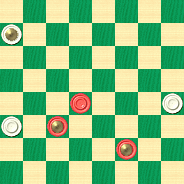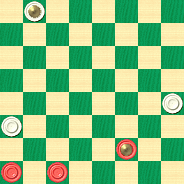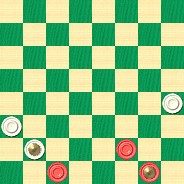The Checker Maven
Jump to navigationSecond Position

Our ballerina above is showing good form in demonstrating Second Position. We'll wager that ballet's Second Position is known to more of the general public than checker's Second Position--- but we'll bet the margin is small.
We continue with our review of the basics in this month's Checker School column, drawn as usual from the erudite pages of Ben Boland's Famous Positions in the Game of Checkers. And what can be more basic than Second Position? You may ask why we even bother with such an old warhorse, as it's been presented in virtually every basic checker textbook since time immemorial.
If you've mastered this position, we'll accept your argument, and you can browse on over to your favorite alternate checker site. But how many of us have really mastered all the nuances? Today, we take you on the backstage tour of Second Position, and by the time you're done, you'll be able to literally dance your way through this tricky but important ending.
Try your hand at the following progressively more difficult three examples.
W. PAYNE
WHITE

BLACK
Black to Play and Win
B:WK28,13,12:B15,K11,K6.
J. STURGES
WHITE

BLACK
Black to Play and Win
B:WK32,13,12:BK6,4,3.
A. ANDERSON
WHITE

BLACK
Black to Play and Win
B:W13,12,K8:B6,3,K1.
Can you solve them all? Never have a "second" thought about clicking on Read More to see detailed notes, a sample game, and virtually all that you'll ever need to know.![]()
Solutions
Diagram No. 1: 15-19, 28-32, 19-24, 32-28, 11-16, 28-19, 16-23, 12-8 23-18 8-3 18-14, 3-8, 6-1, 8-11, 14-9, 13-6, 1-10. Black Wins.
Diagram No. 2: 4-8, 32-27, 8-11, 27-24, 11-16, 24-27---A, 16-19, 27-32, 19-24, 32-28, 24-27, 28-32, 27-31, 32-28, 31-27, 28-32, 27-24, 32-28, 24-19, 28-32, 19-15, 32-28, 15-11, 28-24, 3-7, 24-19, 7-10, 19-24, 10-15, 24-28. Forms Diagram No. 1.
Diagram No. 3: 1-5, 8-11, 5-9, 11-15, 9-14, 15-11---B, 14-18---C, 11-16, 18-15---D, 16-20, 15-11, 20-24, 3-7---E, 24-19, 7-10, 19-23, 10-15, 23-27, 15-19, 27-32, 19-24, 32-28, 24-27*, 28-32, 27-31, 32-28, 31-27, 28-32, 27-23, 32-28, 23-18, 28-24, 18-14, 24-19, 6-10, 19-24, 10-15, 24-28, 15-19, 28-32, 19-24, 32-28, 24-27---F, 28-32, 27-31, 32-28, 31-27, 28-32, 27-24, 32-28, 24-19, 28-32, 19-15, 32-27, 15-10, 27-23, 10-6---G, 23-19, 14-10, 19-23, 10-15, 23-27, now as Payne. 15-19, 27-32, 19-24, 32-28, 11-16. Black Wins.
Game: 11-15, 23-19, 8-11, 22-17, 9-14, 25-22, 11-16, 26-23, 16-20, 31-26---I, 7-11, 19-16, 12-19, 23-7, 2-11, 26-23, 4-8, 23-19, 8-12, 29-25, 5-9, 17-13, 14-18, 19-16, 12-19, 27-23, 18-27, 32-7, 20-27, 7-2, 27-31---J, 22-17, 3-7---K, 2-18, 10-14, 17-10, 6-29, 13-6, 1-10, 21-17---L, 31-27, 17-13, 10-15, 13-9, 15-19, 9-6, 27-23, 6-2, 23-18, 2-6, 18-14, 6-1, 14-10, 1-5, 19-23, 28-24, 23-27, 24-19, 27-31, 19-16, 10-15, 5-9, 31-27, 9-14, 27-23, 16-12, 15-11, 14-17, 23-19, 17-22, 19-15, 30-25---M, 15-10, 25-21, 10-6, 21-17, 6-9, 17-13, 9-14, 22-26, 29-25, 26-23, 25-22, 23-19, 22-26, 19-24, 26-23, 24-28, 23-19, 28-32. Forms above Diagram No. 3, at 16th move from end. R. E. Bowen, June 1, 1869 Draught Board.
A---If 24-20, then 16-19, 20-16, 19-23, 16-19, 23-27, 19-23, 27-31, 23-18, 6-10 (31-26 wins too, as in Strickland's Second Position), 18-23, 10-14, 23-19, 31-27, etc., as Anderson's setting.
B---15-19, 6-10---H, 19-16, 10-15, 16-11, 15-19, 11-15, 19-24, 15-19, 24-27, 19-24. 27-32, 24-20, 32-27, 20-16, 27-23, 16-11, 23-19, 11-16, 19-15, 16-20, 15-11, 20-24, 3-7. Black wins same as Trunk.
C---6-10 would allow a draw by 11-7 while 14-10 is iorced back to same position.
D---Holding the man on 12 while the man on 3 goes for a King. Because the White King is close by 3 must, be crowned before the man on 6. If the White King were in its own double corner then, Black King on 14 and then man on 6 may be crowned, see Note B.
E---The man on 3 holds the White King at bay, driving him into the double corner. In this case man on 3 must be crowned see Notes F, G and H.
F---If the piece on 13 were on 21 or 29 or 30 now, and held by either a piece or a King then the exchange by 11-16 is good. Here 11-16, 28-19, 16-23, 12-8,23-19,8-3,19-15,3-7,15-10,7-11. Draws. See Note M.
G---The proper square to place the King, for the second exchange to have the move on man on 12.
H---The only way against 15-19; If 14-18, 19-24, 18-15, 24-27*, 15-11, 27-23, now Black must go back to Square 14 as in Note B. For if 3-7, then 23-18, 7-10, 18-22, 10-14, 22-25, 14-18, 25-21, 18-23, 21-17,^23-26, 17-14, 26-31, 14-9. Drawn. It should be noticed that if the man on 6 were a King Black wins as in Strickland's Second.
I---30-26 is shown by Janvier to draw, Lee's Guide Page 80.
J---Drummond in his 4th Edition, Vol. 2, Page 36, at 30th move, plays 15-18, and allows White to draw. Bowen.
K---Also on Page 38, G at 16th move, he plays 1-5, and notwithstanding Black wins, White might have drawn. Bowen.
L---Now position No. 14 by R. E. Bowen, same issue of the Draught Board.
M---22-26, 15-10, 26-23, 10-14, 23-26, 14-17, 26-23, 17-21, 23-18, 29-25, 18-23, 25-22, 23-27, 21-17, 27-31, 17-14, 31-27, 14-18, 27-32, 18-23, 32-28, 23-27, 28-32, 27-24, 32-28, 11-16, 28-19, 16-23, 12-8, 23-27, 8-3, 22-26. Black Wins. See Note F.
Diagram No. 1 may be found colors reversed as: Situation No. 6, Critical Situations to win games, in his "Introduction to the Game of Draughts," London 1756.
Diagram No. 2 colors reversed is Situation 38, in "Sturges' Critical Situations on the Game of Draughts," London, 1808.
Diagram No. 3, in Anderson's Second Edition, 1852, this is called "Second Position," with the footnote: "Various stages of this position frequently occur. In the Diagram the play is therefore purposely put back."
You can email the Webmaster with comments on this article.
